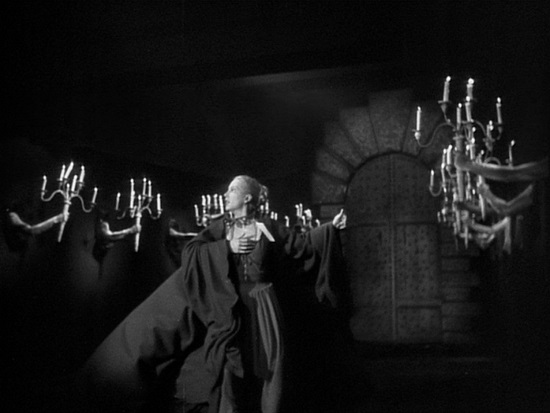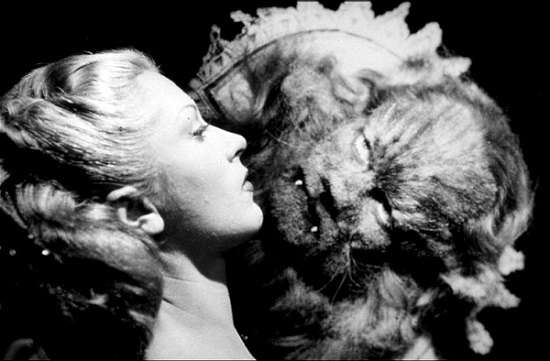Jean Cocteau opens his film adaptation of the classic fairytale Beauty And The Beast like any other fable, with "four magic words" as he puts it – "once upon a time…" But before the story can begin, there are a few conditions: "Children believe what we tell them. They have complete faith in us… I ask of you a little of this childlike sympathy." Cocteau beseeches us to enter into a viewing contract in which we must temporarily adopt the state of mind of a child and suspend our disbelief. If later versions have tended to cater either to mature or young audiences, then La Belle Et La Bête belongs somewhere between childhood and adulthood, nostalgic for the former but earnest in its intentions as a work of art for the latter. Perhaps for this reason it is often referred to as an ‘adult fairytale’, comparing the film rather unfavourably with more recent Hollywood big budget remakes of the Brothers Grimm. But that is to simplify what is a profoundly unusual retelling, one in which the suffering and solitude in Jeanne-Marie LePrince de Beaumont’s original are made explicit.
Cocteau’s fascination with the darker elements of the tale is understandable given the context of the project, begun only four months after the German surrender. In a diary of the filming he rues "the five years of bad blood and spleen… that I’m paying for now", a typical entry in a litany of problems. Disaster struck in the form of blackouts, lack of photographic equipment and supplies, lawsuits, serious injuries to cast members and uncooperative chickens. But in spite of this, the pall cast over the film is less a result of unfortunate circumstance than it is an part of Cocteau’s vision – a fairytale without a happily ever after resolution.
In all other respects the film mostly adheres to the traditional plot. A cursed prince, the Beast (Jean Marais), seeks his true love to break a monstrous curse and restore him to his dashing human form. A young woman, Belle (Josette Day), is forced to wait on her two sisters and brother after the family become bankrupt. Her feckless father loses his way in a forest and finds himself trespassing on the property of a leonine aristocrat, the Beast, who spares his life on the condition he sends one of his daughters – the self-sacrificing Belle, of course – in his stead. Cocteau’s only significant change in his adaptation is the addition of a handsome but aggressive suitor vying for Belle’s hand, serving as a doppelgänger to the Beast. More Prince Harming than Charming, Avenant (also played by Jean Marais) is quick to raise a hand against anyone who dares object to his proposed union with Belle. Unfortunately for him, the lady herself refuses, excusing herself as unable to leave her father’s side. Aside from this, the narrative is "stripped of complicated gesticulation and clutter” and dialogue kept to a minimum so as not to distract from the film’s experimentation with form and aesthetics. Some of the most evocative moments are unspoken, such as the Beast’s silent anguish at Belle’s absence, made painfully evident in a single gesture, when he presses the fur coverlet of her empty bed against his face.
The fantastic is never far removed from reality in La Belle et la Bête. Cocteau praised cinematographer Henry Alken for achieving "a supernatural quality within the limits of realism. It is the reality of childhood. Fairyland without fairies. Fairyland in the kitchen." The magic of the film comes not as an escape from the real but as a shift in the politics of representation. In other words, the film truly captures the essence of the uncanny, that paradoxical sensation of the familiar and foreign. When Belle enters the castle for the first time, she appears to glide in slow motion even as she hurries past the disembodied arms clutching candelabras that protrude from the walls. Only her face is lit, her cloaked figure barely visible in the pitch black interior. As she sweeps up the staircase, her feet are never exposed – hidden by her trailing cloak – giving the impression that she is floating towards the static camera, attracted by some unknown force. Cocteau seems capable of momentarily rendering the commonplace unearthly in such set-pieces.

By turns extravagant and austere, absurd and prosaic, it’s difficult not to admire the film as an exercise in restraint. Rene Clement, the film’s technical advisor, was instructed by Cocteau "…that the style of my film requires ordinary run of the mill stuff… And quite apart from the cost, that’s the way to avoid the picturesque." Although Belle’s chamber is exquisitely decorated by Christian Bérard, it is in harsh contrast to the sparseness of the castle and the barren forest that surrounds it. With the exception of Marcel Escoffier’s meticulous costume design and Georges Auric’s exuberant score, Cocteau reigned in excesses where possible, opting for still shots and minimal sound effects. He believed that true magic came from transformations, the sort that only cinema could make possible. Cinematography, in the form of montages, projections and transitions, is the alchemy of La Belle et la Bête. Pearl necklaces become rotting vines in the wrong hands, glistening teardrops transmute into diamonds, billowing silk curtains heralding Belle’s first meeting with the Beast later reappear as drying bed sheets when she returns to the domestic servitude of her home.
It is from the visual rather than verbal that the film’s magic comes. The various transfigurations and metamorphoses all play on image associations; the source of which is the enchanted mirror. It is the surface on which the onlooker’s inner most thoughts, anxieties and desires are projected. "Reflect for me and I will reflect for you," whispers the mirror to Belle. Whereas vision is fallible – Belle’s eyes cannot meet the Beast’s as it causes him pain, and her distress – reflections reveal all: through the looking glass Belle sees the Beast dying after she breaks her promise to return to him. The mirror tells of realities obscured from view, it prompts revelations, and not always pleasing ones at that. When Belle’s tyrannising sisters check their reflection, they find themselves staring back at a hag and a monkey. For Cocteau, mirrors hold a unique appeal as a cinematic metaphor, one that appears throughout his work: in Le Sang d’un Poète, the protagonist enters into his unconscious through a mirror that becomes a pool of water. "The movie screen," he wrote, "is the true mirror reflecting the flesh and blood of my dreams."
In a tale of transformations, it is ironic that the final denouement, the lifting of the Beast’s curse, should be the most bathetic of them all. Belle gets her Prince but not without a catch: he’s the spitting image of her ill-tempered suitor Avenant. There is overwhelming sense of disappointment in the ending scene, the note of dissatisfaction in Belle’s lines is delivered by Josette Day with a composure that belies dismay. She accepts the transformed Beast as a compromise, a slight improvement on the alternative. Greta Garbo’s now immortalised riposte to the film, "Give me back my beast", summed up the desire for altogether different ending. Belle’s final words, by contrast, seems to have been forgotten. "I like being afraid,” she admits to the Beast, a late realisation that the thrill of the monster cannot match the man. Better to be a little afraid than bored, Belle suggests. The same maxim could be applied to Cocteau’s film, an old tale, but one that still packs the shock of the new.
La Belle Et La Bete is out now on DVD via BFI


